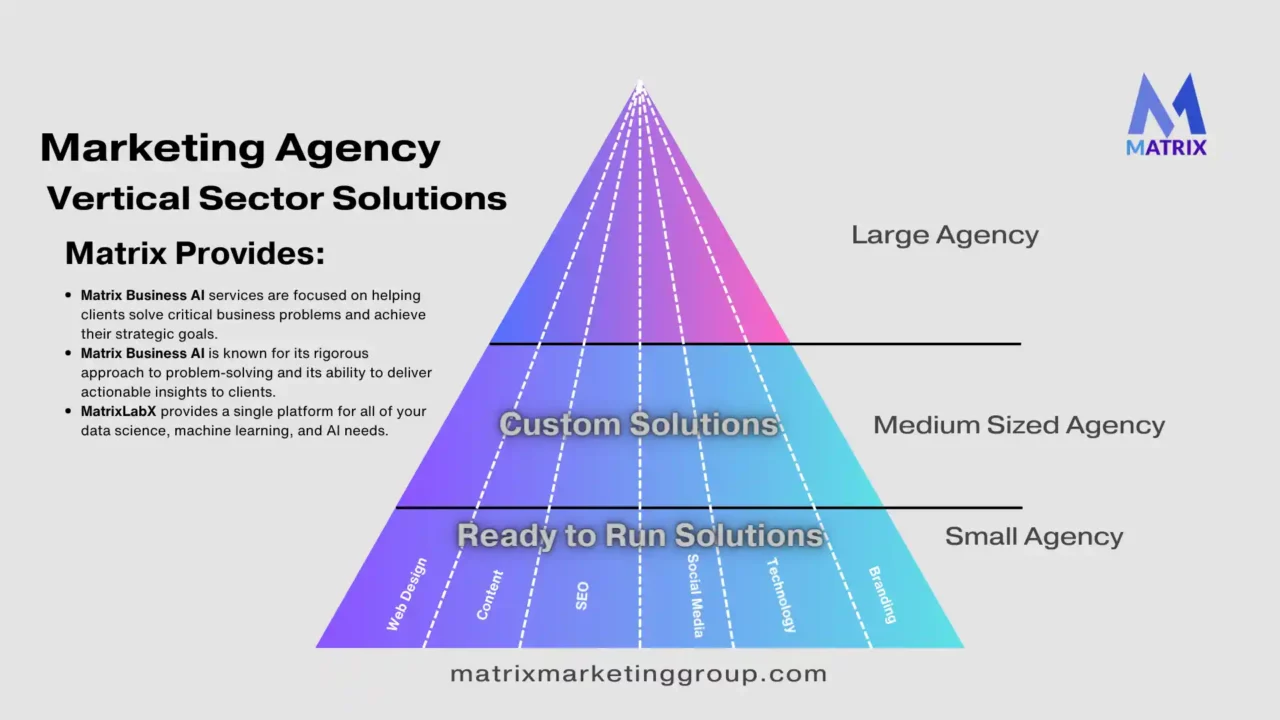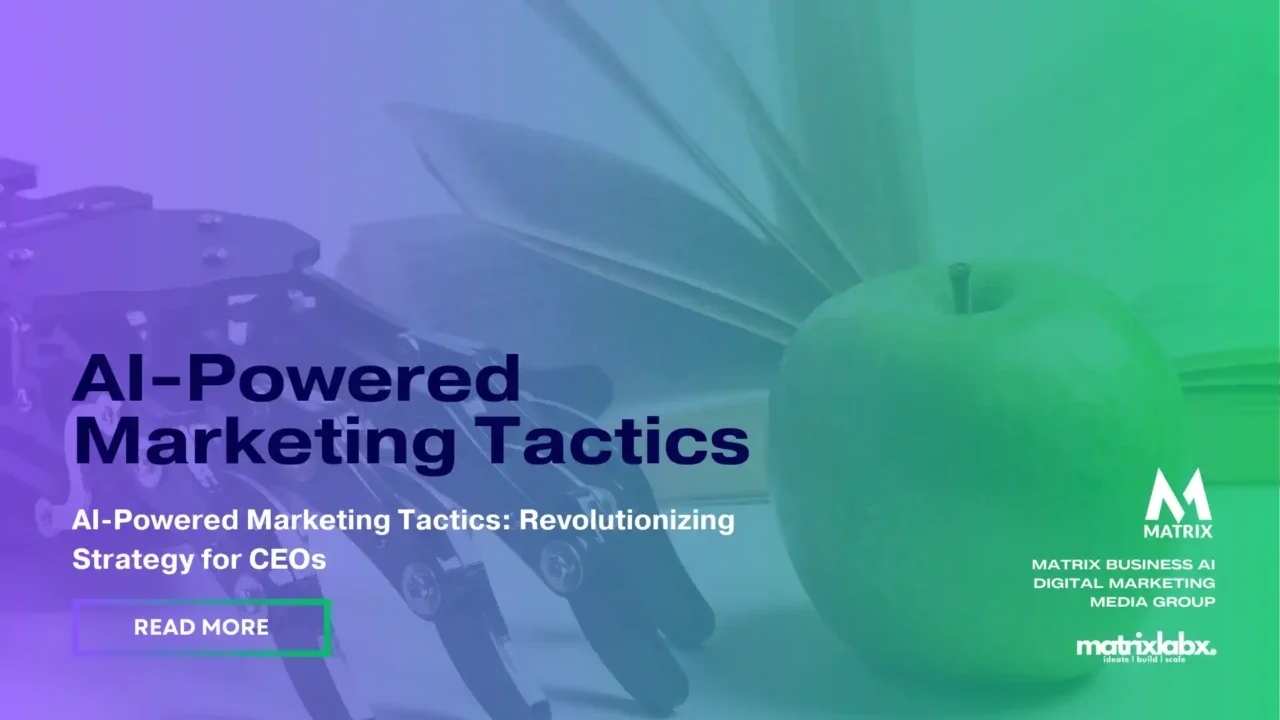AI-Powered Marketing Tactics: Revolutionizing Strategy for CEOs
Learn about AI-Powered Marketing Tactics: Revolutionizing Strategy for CEOs
Embracing the Future: How AI Transforms Marketing
In the dynamic world of digital marketing, staying ahead of the curve is not just an advantage; it’s a necessity. For CEOs looking to spearhead their organization’s growth, understanding and implementing AI-powered marketing tactics is pivotal.
This evolution in marketing isn’t just about automation or data analysis; it’s a comprehensive transformation of how we understand, interact with, and engage our audiences.
Problem Identification: The Changing Marketing Landscape
The traditional marketing landscape is undergoing a seismic shift. In an era where consumer behaviors and market trends are rapidly changing, traditional strategies are losing their impact. The problem facing today’s CEOs is clear:
How do you adapt to these changes effectively and efficiently? The answer lies in leveraging the power of Artificial Intelligence (AI) in your marketing strategies.
Agitation: The Challenges of Adaptation
Adapting to AI-driven marketing is not without its challenges. The integration of AI into existing systems can be complex, and there is often a knowledge gap in understanding how to fully utilize this technology.
Moreover, the pace at which AI is evolving can make it daunting for leaders to make informed decisions about which tools and tactics will be most beneficial for their business.
Solution: Harnessing AI for Enhanced Marketing Strategies
The solution to these challenges is multi-faceted. Firstly, understanding the scope of AI in marketing is essential.
AI can provide unparalleled insights into customer behavior, predict market trends, and automate routine tasks, freeing up valuable resources to focus on strategy and innovation.
Secondly, implementing AI-driven tactics such as personalized marketing campaigns, predictive analytics, and chatbots can dramatically improve customer engagement and satisfaction.
The Path Forward: AI as a Strategic Partner

The integration of AI in marketing is not just about adopting new technology; it’s about rethinking the role of marketing in your business strategy.
AI can be a strategic partner, providing insights that inform decision-making and drive growth.
For CEOs, embracing AI in marketing means being at the forefront of innovation, leading their companies with a competitive edge in a rapidly evolving digital world.
In conclusion, AI-powered marketing tactics are not just the future; they are the present.
By understanding and implementing these tactics, CEOs can ensure their organizations survive and thrive in the ever-changing digital landscape.
Here are some intriguing and lesser-known statistics about AI-powered marketing tactics:
- Adoption and Attitude Towards AI: 87% of organizations globally see AI technologies as a competitive edge. Additionally, 78% of companies emphasize the importance of AI results being fair, safe, and reliable. Interestingly, 61% of employees have reported improved productivity due to AI, with an expected 40% improvement in employee productivity through AI use.
- AI’s Economic Contribution and Growth: By 2030, AI is expected to contribute an astonishing $16 trillion to the global economy. The global AI market, valued at $142 billion in 2023, is projected to reach a market size of $1.59 trillion by 2030. The compound annual growth rate (CAGR) of AI globally stands at 37%, highlighting its rapid growth and expanding influence.
- Impact on Digital Marketing: AI-powered content optimization is recognized for significantly increasing website performance and ROI. AI’s role in search engine algorithms has led to more accurate, targeted results, enhancing brand engagement. With AI-driven marketing spend projected to increase by 50% in 2023, over 40% of marketing professionals are currently utilizing AI-driven technologies. This adoption rate is expected to rise further, with studies indicating a fivefold return on investment from using AI in marketing.
- Generative AI in Content Creation: Over 73% of B2B and B2C marketing executives are using generative AI for tasks like brainstorming, generating first drafts, and producing final content. Remarkably, generative AI saves an average of three hours per content piece, with 89% of marketers attesting to improved content quality. However, there’s a challenge with AI-generated content sometimes producing inaccurate information, highlighting the need for human oversight.
- Future Outlook and Challenges: The future of marketing is closely intertwined with AI, but it’s not without challenges. Concerns about risk and governance, lack of education and training, and limited AI skills and knowledge are significant barriers to its adoption. Despite these challenges, AI’s impact on customer experience, time savings for marketers, and increased targeting accuracy is undeniable and is set to reshape marketing strategies profoundly.
These stats paint a picture of a rapidly evolving landscape in AI-powered marketing, where the technology not only drives efficiency and effectiveness but also presents new challenges and learning opportunities for businesses.
Navigating the AI Maze: Top Challenges for CEOs in AI-Powered Marketing
AI-powered marketing is like navigating a new frontier, full of promise but also riddled with challenges.
As CEOs venture into this evolving landscape, they face unique hurdles that can impact the trajectory of their companies. Here, we delve into three critical challenges that AI-powered marketing presents to CEOs.
Keeping Pace with Rapid Technological Advancements
In the world of AI, technology evolves at breakneck speed. CEOs must not only stay informed but also anticipate future trends to maintain a competitive edge.
The Challenge of Constant Learning
AI in marketing isn’t static; it’s a constantly shifting ground. CEOs need to invest time and resources in ongoing education and training, both for themselves and their teams.
Keeping abreast of the latest AI advancements is crucial, but it can be overwhelming given the pace at which new technologies and methodologies emerge.
Risk of Obsolescence
The risk here is twofold: falling behind in adopting new technologies, and investing in AI tools that quickly become outdated.
CEOs must develop a keen sense for distinguishing fleeting trends from enduring advancements, a skill that is as much intuitive as it is informed by data.
Balancing AI Integration with Human Creativity
While AI can analyze data and predict trends, it lacks the human touch essential for creative and strategic thinking.
The Human-AI Synergy
The real challenge lies in finding the sweet spot where AI’s analytical power enhances human creativity, rather than replacing it.
CEOs must champion strategies that leverage AI for data-driven insights while fostering an environment where human creativity can thrive.
Guarding Against Over-Reliance on AI
There’s a fine line between using AI as a tool and becoming overly dependent on it. CEOs need to ensure that AI is used to supplement human judgment, not substitute it.
This involves setting clear boundaries and expectations for the role of AI in the marketing process.
Navigating Ethical and Privacy Concerns
AI’s ability to collect and analyze massive amounts of consumer data raises significant ethical and privacy issues.
Ethical Implications of AI
CEOs must navigate the complex ethical landscape surrounding AI in marketing.
This includes concerns over consumer privacy, data security, and the potential for AI to perpetuate biases. Establishing ethical guidelines for AI use is not just a legal imperative but also a matter of corporate responsibility.
Privacy and Consumer Trust
In an age where data breaches are common, protecting consumer data is paramount. CEOs must ensure that their companies’ use of AI in marketing respects consumer privacy and complies with evolving regulations.
Building and maintaining consumer trust is essential in an era where privacy concerns are at the forefront of public consciousness.
While AI-powered marketing opens a world of possibilities, it also presents a labyrinth of challenges for CEOs.
Navigating this maze requires a delicate balance of embracing technological advancements, fostering human-AI synergy, and upholding ethical standards. The CEOs who can skillfully manage these challenges will lead their companies to new heights in the AI-driven future of marketing.
Decoding AI-Powered Marketing: A CMO’s Guide
In the dynamic world of digital marketing, AI-powered strategies have become a pivotal focus.
This guide breaks down the ‘who, what, where, when, and why’ of AI-powered marketing tactics, tailored for the Chief Marketing Officer (CMO) keen on navigating this innovative landscape.
Who: The CMO’s Role in AI-Driven Marketing
The Vanguard of Change
As the chief architect of a company’s marketing strategy, the CMO plays a critical role in integrating AI into the marketing mix.
It’s the CMO who must understand the capabilities of AI technologies and lead their teams in leveraging these tools to drive marketing success.
Collaborative Leadership
The CMO’s role extends beyond just decision-making; it involves fostering a collaborative environment where AI experts, data scientists, and marketing professionals work together to achieve common goals. This synergy is crucial for the successful implementation of AI-driven strategies.
What: The Essence of AI in Marketing
A New Frontier of Possibilities
AI in marketing encompasses a range of technologies, from machine learning algorithms analyzing customer data to AI-driven content creation tools. These technologies offer unparalleled insights into customer behavior, market trends, and campaign effectiveness.
Enhancing Marketing Efficiency
AI’s power lies in its ability to automate repetitive tasks, personalize customer experiences, and predict future market trends.
This not only improves efficiency but also opens up new avenues for creative and strategic marketing endeavors.
Where: AI’s Place in the Marketing Ecosystem
Integrating AI Across Channels
AI-powered marketing isn’t confined to a single platform or channel. It spans across various facets of digital marketing – social media, email campaigns, content marketing, and more.
The CMO must ensure AI is seamlessly integrated across all these channels for a unified marketing approach.
The Digital Battleground
The digital realm is where AI truly shines. Online platforms offer a wealth of data that AI tools can analyze to drive strategic decisions.
The CMO’s focus should be on leveraging these digital platforms to maximize the impact of AI-driven tactics.
When: Timing the AI Marketing Revolution
The Dawn of a New Era
There’s no better time than now for CMOs to embrace AI in marketing.
The rapid advancements in AI technology mean that delaying its integration could result in falling behind competitors who are already reaping the benefits of AI.
A Continuous Journey
Implementing AI in marketing is not a one-time project; it’s an ongoing journey.
CMOs should view this as a continuous process of learning, adapting, and evolving with the technology to stay ahead in the ever-changing marketing landscape.
Why: The Imperative of AI in Marketing
Staying Ahead of the Curve
In today’s competitive market, not leveraging AI in marketing strategies is a missed opportunity. AI offers a significant competitive advantage, from understanding customer needs to predicting future market trends.
Driving Growth and Innovation
The ultimate goal of AI in marketing is to drive business growth and foster innovation.
For CMOs, harnessing the power of AI is key to developing marketing strategies that are not only effective but also pioneering and forward-thinking.
In conclusion, for CMOs, the journey into AI-powered marketing tactics is both a challenge and an opportunity. It requires a strategic mindset, a willingness to embrace new technologies, and a commitment to continuous learning and adaptation.
By understanding the who, what, where, when, and why of AI in marketing, CMOs can lead their teams to new heights of marketing excellence.
Unveiling the Power of AI in Marketing: Real-World Use Cases
In the realm of digital marketing, AI has emerged as a game-changer, transforming traditional strategies into dynamic, data-driven campaigns.
Let’s explore three compelling use cases of AI-powered marketing tactics, employing the Before-After-Bridge (BAB) format to demonstrate their transformative impact.
1. Personalized Customer Experiences
Before: The Challenge of Generic Marketing
Imagine a world where marketing strategies are one-size-fits-all. Businesses struggle to connect with their diverse audience, resulting in low engagement and poor conversion rates.
After: AI-Driven Personalization
Enter AI-powered personalization. By analyzing customer data and behavior, AI tailors marketing messages and offers to individual preferences, creating a unique and relevant experience for each customer.
Bridge: The Path to Personalization
AI algorithms sift through vast amounts of data, identifying patterns and preferences.
This allows marketers to craft targeted campaigns that resonate personally with each customer, leading to higher engagement and loyalty.
2. Predictive Analytics for Strategic Planning
Before: Uncertainty in Marketing Decisions
Traditionally, marketers base their strategies on past trends and gut feelings, often leading to hit-or-miss campaigns and wasted resources.
After: Insightful Predictions with AI
AI revolutionizes this approach through predictive analytics. It anticipates future consumer behaviors and market trends, enabling businesses to make informed, strategic decisions.
Bridge: Leveraging AI for Foresight
By harnessing the power of machine learning, AI analyses current and historical data to forecast future market movements. This predictive insight empowers marketers to proactively adapt their strategies, ensuring relevance and effectiveness.
3. Enhanced Customer Service with AI Chatbots
Before: The Limitations of Traditional Customer Service
Traditional customer service models often struggle with high volumes of inquiries, leading to long wait times and frustrated customers.
After: AI Chatbots Transforming Customer Interactions
AI chatbots revolutionize customer service. They provide instant, 24/7 support, handling inquiries efficiently and precisely, vastly improving the customer experience.
Bridge: Implementing AI for Responsive Service
By integrating AI chatbots, businesses can manage customer queries effectively, regardless of volume. These bots understand and respond to a wide range of customer needs, offering timely solutions and freeing up human agents to handle more complex issues.
In conclusion, these use cases of AI-powered marketing tactics showcase AI’s profound impact on enhancing customer experiences, strategic decision-making, and customer service efficiency.
As AI continues to evolve, its potential to revolutionize marketing strategies becomes increasingly clear, offering businesses unparalleled opportunities for growth and innovation.
Mastering AI-Powered Marketing Automation: A Step-by-Step Guide
Embracing AI-powered marketing automation can seem daunting, but it’s an essential leap for businesses aiming to stay ahead in the digital age.
This guide offers a step-by-step approach to implementing AI in your marketing tactics, ensuring a smooth transition and optimal results.
Step 1: Define Your Marketing Objectives
Identifying Your Goals
Before diving into AI, clearly define what you want to achieve. Are you looking to enhance customer engagement, increase sales, or improve your marketing ROI? Having clear objectives will guide your AI implementation strategy.
Aligning AI with Business Goals
Ensure that your marketing objectives align with your overall business goals. This alignment is crucial for measuring the success of your AI initiatives.
Step 2: Assess Your Data Infrastructure
Evaluating Your Data Capabilities
AI thrives on data. Assess your current data collection and management systems. Do you have enough quality data? Is it well-organized and accessible?
Upgrading Data Systems if Needed
If your data infrastructure is lacking, consider investing in upgrades or new systems. This may include more robust CRM software or cloud-based storage solutions.
Step 3: Choose the Right AI Tools
Researching AI Marketing Tools
With a plethora of AI tools available, research is key. Look for tools that align with your specific marketing goals. Consider factors like ease of use, integration capabilities, and cost.
Trial and Integration
Many AI tools offer trial periods. Use these to test how well they integrate with your existing systems and how effectively they meet your needs.
Step 4: Implement AI Gradually
Starting Small
Begin with one or two AI tools or features. This could be AI-powered analytics for customer insights or chatbots for customer service.
Monitoring and Adjusting
As you implement these tools, closely monitor their performance and impact. Be prepared to make adjustments as needed. This iterative approach helps in fine-tuning your AI strategy without overwhelming your team or resources.
Step 5: Train Your Team
Educating Your Staff
AI tools are most effective when your team knows how to use them. Invest in training sessions for your staff to ensure they are comfortable and proficient with the new technology.
Encouraging a Culture of Adaptation
Foster a culture that is open to change and innovation. Encourage your team to experiment with AI features and provide feedback.
Step 6: Measure and Optimize
Tracking Performance Against Goals
Regularly measure the performance of your AI tools against your initial marketing objectives. Use metrics like engagement rates, conversion rates, and ROI.
Continuous Optimization
AI is not a set-and-forget solution. Continuously analyze performance data and use these insights to optimize your strategies. Be open to exploring new AI features or tools as they become available.
In conclusion, automating your marketing tactics with AI requires careful planning, a strong data foundation, a gradual implementation approach, ongoing team education, and continuous optimization.
By following these steps, you can harness the power of AI to transform your marketing strategies, driving growth and staying competitive in today’s fast-paced digital landscape.

Stop Wasting Ads! Get Laser-Targeted Clicks (and Customers)
Tired of ad duds? Get eyeballs on your brand with laser-focused online ads that convert. Click to unleash the power of targeted marketing!

Stop Scrolling, Start Selling: Social Ads That Convert Like Crazy
Get ready to unleash the power of AI-targeted ads that turn likes into leads and leads into SALES.

